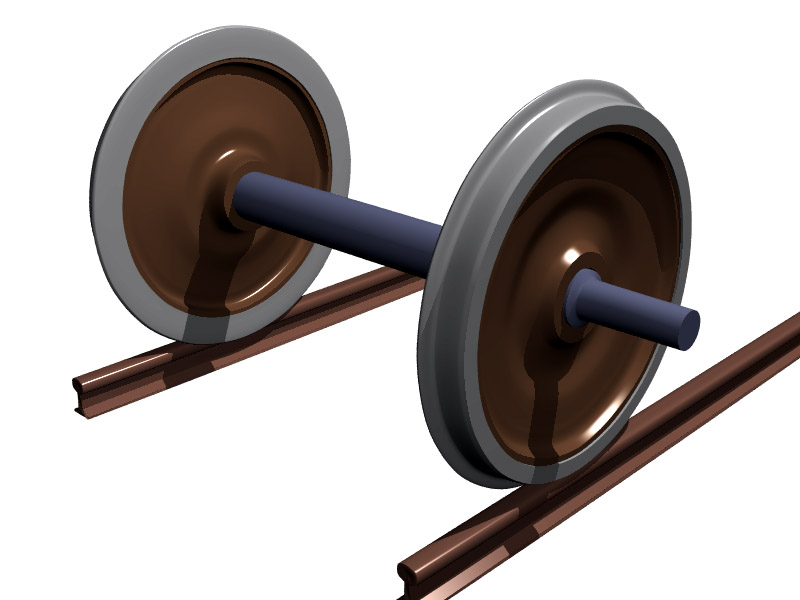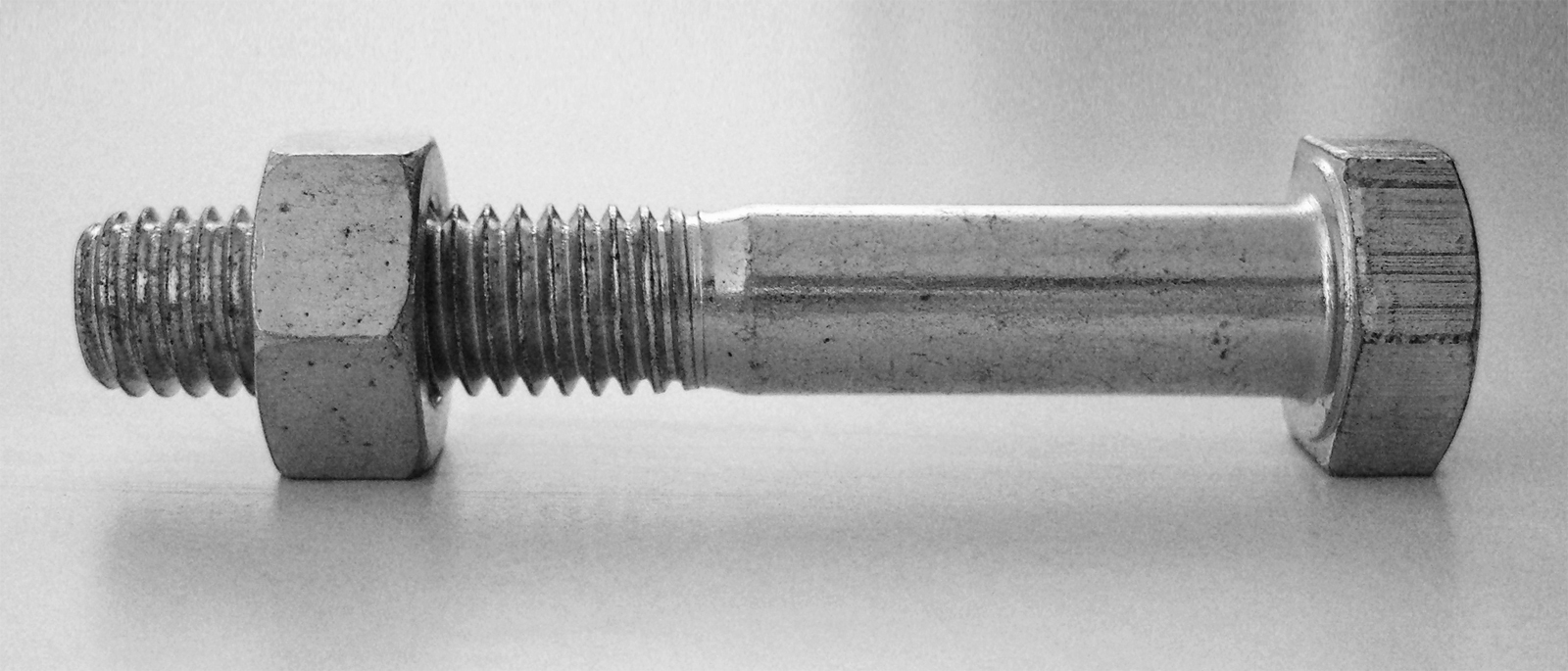|
Axle
An axle or axletree is a central shaft for a rotation, rotating wheel and axle, wheel or gear. On wheeled vehicles, the axle may be fixed to the wheels, rotating with them, or fixed to the vehicle, with the wheels rotating around the axle. In the former case, bearing (mechanical), bearings or Bushing (bearing), bushings are provided at the mounting points where the axle is supported. In the latter case, a bearing or bushing sits inside a central hole in the wheel to allow the wheel or gear to rotate around the axle. Sometimes, especially on bicycles, the latter type of axle is referred to as a ''spindle (tool), spindle''. Terminology On cars and trucks, several senses of the word ''axle'' occur in casual usage, referring to the shaft itself, its housing, or simply any transverse pair of wheels. Strictly speaking, a shaft that rotates with the wheel, being either Bolt (fastener), bolted or rotating spline, splined in fixed relation to it, is called an ''axle'' or ''axle shaft ... [...More Info...] [...Related Items...] OR: [Wikipedia] [Google] [Baidu] |
Bushing (bearing)
Plain bearing on a 1906 S-Motor locomotive showing the axle, bearing, oil supply and oiling pad A sliding table with four cylindrical bearings A wheelset from a Great Western Railway (GWR) wagon showing a plain, or journal, bearing end A plain bearing, or more commonly sliding contact bearing and slide bearing (in railroading sometimes called a solid bearing, journal bearing, or friction bearing), is the simplest type of bearing, comprising just a bearing surface and no rolling elements. Therefore, the part of the shaft in contact with the bearing slides over the bearing surface. The simplest example of a plain bearing is a shaft rotating in a hole. A simple linear bearing can be a pair of flat surfaces designed to allow motion; e.g., a drawer and the slides it rests on or the ways on the bed of a lathe. Plain bearings, in general, are the least expensive type of bearing. They are also compact and lightweight, and they have a high load-carrying capacity. Design The ... [...More Info...] [...Related Items...] OR: [Wikipedia] [Google] [Baidu] |
Driveshaft
A drive shaft, driveshaft, driving shaft, tailshaft (Australian English), propeller shaft (prop shaft), or Cardan shaft (after Girolamo Cardano) is a component for transmitting mechanical power, torque, and rotation, usually used to connect other components of a drivetrain that cannot be connected directly because of distance or the need to allow for relative movement between them. As torque carriers, drive shafts are subject to torsion and shear stress, equivalent to the difference between the input torque and the load. They must therefore be strong enough to bear the stress, while avoiding too much additional weight as that would in turn increase their inertia. To allow for variations in the alignment and distance between the driving and driven components, drive shafts frequently incorporate one or more universal joints, jaw couplings, or rag joints, and sometimes a splined joint or prismatic joint. History The term ''driveshaft'' first appeared during the mid-19th ... [...More Info...] [...Related Items...] OR: [Wikipedia] [Google] [Baidu] |
Rotating Spline
A spline is a ridge or tooth on a drive shaft that matches with a groove in a mating piece and transfers torque to it, maintaining the angular correspondence between them. For instance, a gear mounted on a shaft might use a male spline on the shaft that matches the female spline on the gear. Adjacent images in the section below show a transmission input shaft with male splines and a clutch plate with mating female splines in the center hub, where the smooth tip of the axle would be supported in a pilot bearing in the flywheel (not pictured). An alternative to splines is a keyway and key, though splines provide a longer fatigue life, and can carry significantly greater torques for the size. Types There are several types of splines: ;Parallel key spline: where the sides of the equally spaced grooves are parallel in both directions, radial and axial. ;Involute spline: where the sides of the equally spaced grooves are involute, as with an involute gear, but not as tall. The c ... [...More Info...] [...Related Items...] OR: [Wikipedia] [Google] [Baidu] |
Universal Joint
A universal joint (also called a universal coupling or U-joint) is a joint or coupling connecting rigid shafts whose axes are inclined to each other. It is commonly used in shafts that transmit rotary motion. It consists of a pair of hinges located close together, oriented at 90° to each other, connected by a cross shaft. The universal joint is not a constant-velocity joint. U-joints are also sometimes called by various eponymous names, as follows: * Cardan joint, after Gerolamo Cardano, a polymath of the 16th century who contributed to knowledge of various clever mechanisms, including gimbals * Hooke joint or Hooke's joint, after Robert Hooke, a polymath of the 17th century who contributed to knowledge of various clever mechanisms * Spicer joint, after Clarence W. Spicer and the Spicer Manufacturing Company, who manufactured U joints * Hardy Spicer joint, after the Hardy Spicer brand, a successor to the Spicer brand History The main concept of the universal joi ... [...More Info...] [...Related Items...] OR: [Wikipedia] [Google] [Baidu] |
Constant-velocity Joint
A constant-velocity joint (also called a CV joint and homokinetic joint) is a mechanical coupling which allows the shafts to rotate freely (without an appreciable increase in friction or Backlash (engineering), backlash) and compensates for the angle between the two shafts, within a certain range, to maintain the same velocity. A common use of CV joints is in front-wheel drive vehicles, where they are used to transfer the engine's power to the wheels, even as the angle of the driveshaft varies due to the operation of the steering and Car suspension, suspension. History The predecessor to the constant-velocity joint was the universal joint (also called a ''Cardan joint'') which was invented by Gerolamo Cardano in the 16th century. A short-coming of the universal joint is that the rotational speed of the output shaft fluctuates despite the rotational speed of the input shaft being constant. This fluctuation causes unwanted vibration in the system and increases as the angle betwe ... [...More Info...] [...Related Items...] OR: [Wikipedia] [Google] [Baidu] |
Swing Axle
A swing axle is a simple type of independent suspension designed and patented by Edmund Rumpler in 1903 for the rear axle of rear wheel drive vehicles. This was a revolutionary invention in automotive suspension, allowing driven (powered) wheels to follow uneven road surfaces independently, thus enabling the vehicle's wheels to maintain better road contact and holding; plus each wheel's reduced unsprung weight means their movements have less impact on the vehicle as a whole. The first automotive application was the Rumpler Tropfenwagen, another early example was the 1923 Tatra 11 later followed by the Mercedes 130H/150H/170H, the Standard Superior, the pre-facelift Volkswagen Beetle and most of its derivatives, the Chevrolet Corvair, and the roll-over prone M151 jeep amongst others. Many later automobile rear swing axles have universal joints connecting the driveshafts to the differential, which is attached to the chassis. Swing axles do not have universal joints at the w ... [...More Info...] [...Related Items...] OR: [Wikipedia] [Google] [Baidu] |
Torque
In physics and mechanics, torque is the rotational analogue of linear force. It is also referred to as the moment of force (also abbreviated to moment). The symbol for torque is typically \boldsymbol\tau, the lowercase Greek letter ''tau''. When being referred to as moment of force, it is commonly denoted by . Just as a linear force is a push or a pull applied to a body, a torque can be thought of as a twist applied to an object with respect to a chosen point; for example, driving a screw uses torque to force it into an object, which is applied by the screwdriver rotating around its axis to the drives on the head. Historical terminology The term ''torque'' (from Latin , 'to twist') is said to have been suggested by James Thomson and appeared in print in April, 1884. Usage is attested the same year by Silvanus P. Thompson in the first edition of ''Dynamo-Electric Machinery''. Thompson describes his usage of the term as follows: Today, torque is referred to using d ... [...More Info...] [...Related Items...] OR: [Wikipedia] [Google] [Baidu] |
Wheel
A wheel is a rotating component (typically circular in shape) that is intended to turn on an axle Bearing (mechanical), bearing. The wheel is one of the key components of the wheel and axle which is one of the Simple machine, six simple machines. Wheels, in conjunction with axles, allow heavy objects to be moved easily facilitating movement or transportation while supporting a load, or performing labor in machines. Wheels are also used for other purposes, such as a ship's wheel, steering wheel, potter's wheel, and flywheel. Common examples can be found in transport applications. A wheel reduces friction by facilitating motion by rolling together with the use of axles. In order for a wheel to rotate, a Moment (physics), moment must be applied to the wheel about its axis, either by gravity or by the application of another external force or torque. Terminology The English word '':wikt:wheel, wheel'' comes from the Old English word , from Proto-Germanic language, Proto-Germanic , ... [...More Info...] [...Related Items...] OR: [Wikipedia] [Google] [Baidu] |
Wheel And Axle
The wheel and axle is a simple machine, consisting of a wheel attached to a smaller axle so that these two parts rotate together, in which a force is transferred from one to the other. The wheel and axle can be viewed as a version of the lever, with a drive force applied tangentially to the perimeter of the wheel, and a load force applied to the axle supported in a bearing, which serves as a fulcrum. History The Halaf culture of 6500–5100 BCE has been credited with the earliest depiction of a wheeled vehicle, but this is doubtful as there is no evidence of Halafians using either wheeled vehicles or even pottery wheels. One of the first applications of the wheel to appear was the potter's wheel, used by prehistoric cultures to fabricate clay pots. The earliest type, known as "tournettes" or "slow wheels", were known in the Middle East by the 5th millennium BCE. One of the earliest examples was discovered at Tepe Pardis, Iran, and dated to 5200–4700 BCE. These wer ... [...More Info...] [...Related Items...] OR: [Wikipedia] [Google] [Baidu] |
Bolt (fastener)
A bolt is an externally helical threaded fastener capable of being tightened or released by a twisting force ( torque) to a matching nut. The bolt has an external male thread requiring a matching nut with a pre-formed female thread. History Nuts and bolts were originally hand-crafted together, so that each nut matched its own bolt, but they were not interchangeable. This made it virtually impossible to replace lost or damaged fixers, as they were all different. Joseph Whitworth in 1841 proposed that a standard should be set, but it did not happen immediately. In 1851 the Great Exhibition of the Works of Industry of All Nations was to be held in Hyde Park, London, England, and it was decided to build the Crystal Palace as part; this had to be done in 190 days, and at reasonable cost. Research into the remains of the destroyed building in 2024 revealed a major innovation that made this possible. The construction firm responsible, Fox Henderson, decided to use nuts and bo ... [...More Info...] [...Related Items...] OR: [Wikipedia] [Google] [Baidu] |






